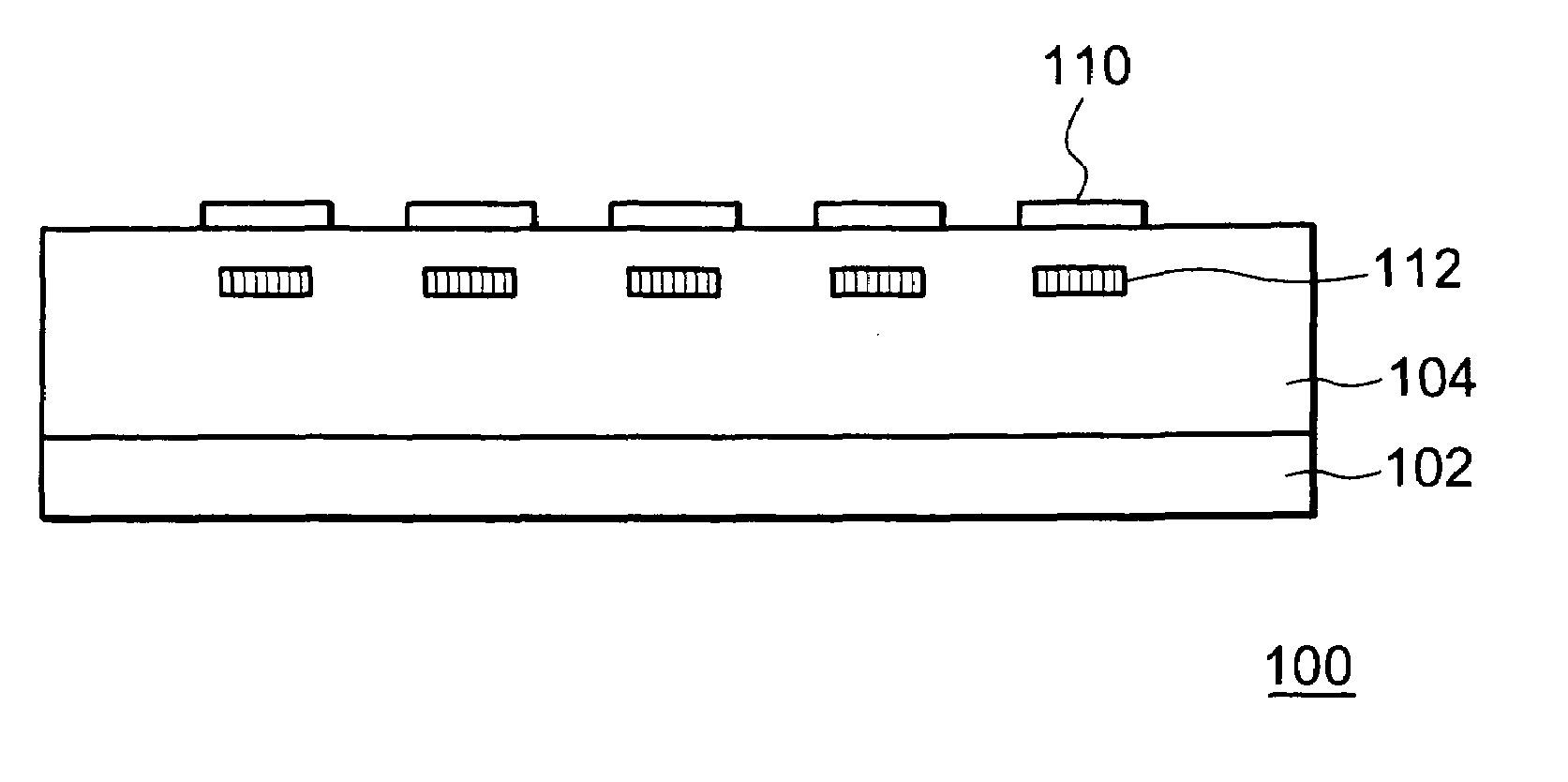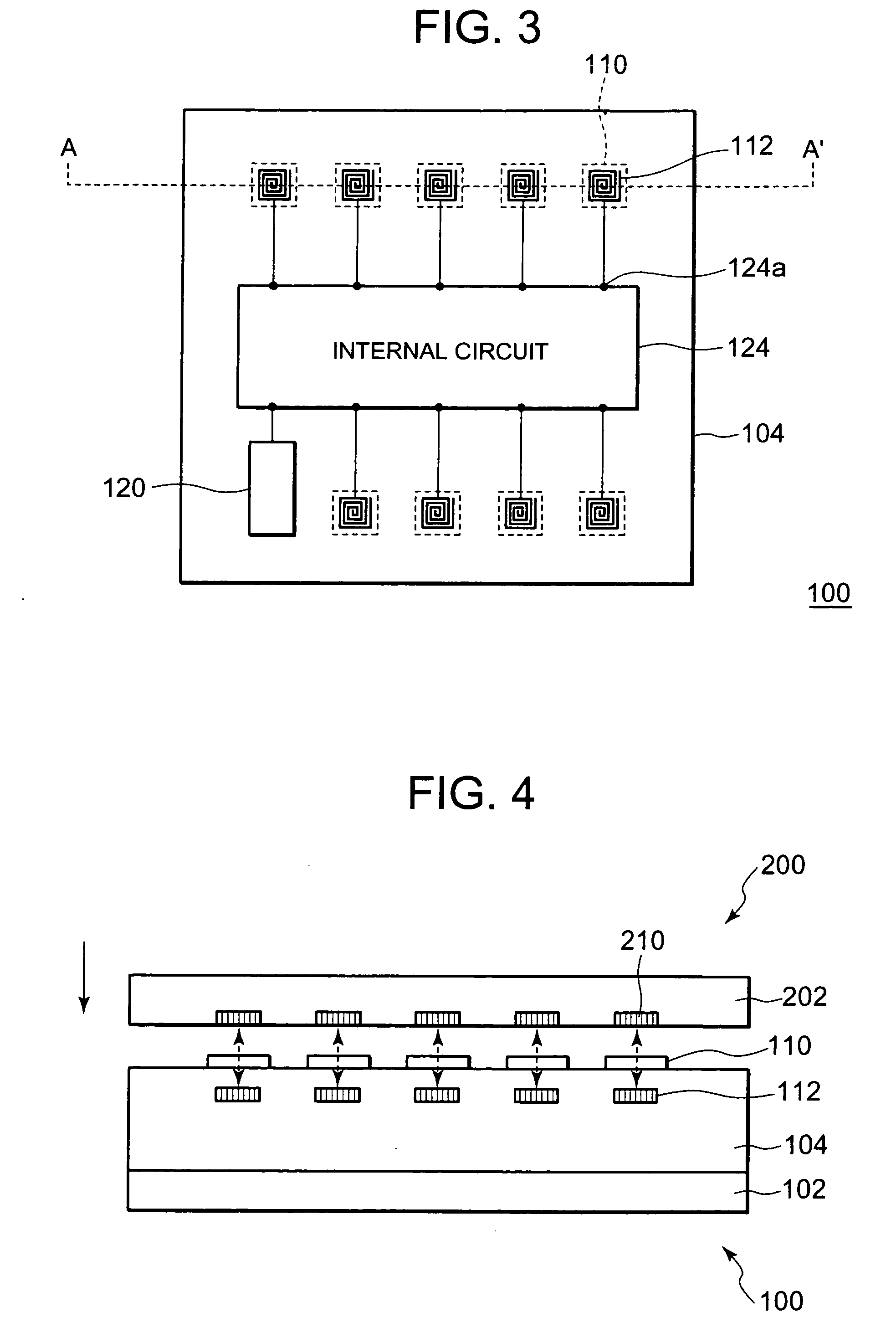Semiconductor device, method of manufacturing thereof, signal transmission/reception method using such semiconductor device, and tester apparatus
- Summary
- Abstract
- Description
- Claims
- Application Information
AI Technical Summary
Benefits of technology
Problems solved by technology
Method used
Image
Examples
first embodiment
[0042]FIGS. 1 to 3 illustrate an exemplary structure of a semiconductor device 100 according to the present invention. FIG. 1 is a sectional view of the semiconductor device 100 and FIGS. 2 and 3 are plan views of the semiconductor device 100. FIG. 1 is a sectional view taken along the line A-A′ of FIG. 2 and FIG. 3.
[0043]As illustrated in FIG. 1, the semiconductor device 100 includes a semiconductor substrate 102 (substrate) and an insulating film 104 provided on the semiconductor substrate 102. The semiconductor device 100 also includes inductors 112 (first signal transmitting / receiving portion) provided in the insulating film 104 on the semiconductor substrate 102, and bonding pads 110 provided above the semiconductor substrate 102 so as to be superimposed on the inductors 112. Here, the semiconductor device 100 may be in a state before the semiconductor substrate 102 is divided into chips. The semiconductor substrate 102 may be, for example, a semiconductor wafer such as a silic...
second embodiment
[0067]FIG. 6 is a sectional view illustrating an exemplary structure of a semiconductor device 100 according to the present invention.
[0068]This embodiment is different from the embodiment described with reference to FIGS. 1 to 5 in that a plurality of inductors are provided under each of the bonding pads 110.
[0069]An inductor 112c, an inductor 112b, and an inductor 112a are stacked above the semiconductor substrate 102 in this order. The inductor 112c, the inductor 112b, and the inductor 112a may be inductors which are independent of one another such that phases of signals detected by the respective inductors are different from one another. Here, a plurality of inductors (inductor 112c, inductor 112b, and inductor 112a) are provided similarly under each of the bonding pads 110.
[0070]FIG. 7 is a sectional view illustrating a structure of a tester 200 for supplying a signal to the semiconductor device 100 and the semiconductor device 100 according to the second embodiment of the pres...
third embodiment
[0074]FIG. 8A is a sectional view illustrating an exemplary structure of a semiconductor device 100 according to the present invention.
[0075]In this embodiment, a plurality of inductors are provided below each of the bonding pads 110 similarly to the case illustrated in FIG. 6, but this embodiment is different from the embodiment described with reference to FIG. 6 in that the inductors are provided at locations shifted from one another in the plan view.
[0076]FIG. 8B is a sectional view illustrating a structure of a tester 200 for supplying a signal to the semiconductor device 100 according to the third embodiment of the present invention.
[0077]When the semiconductor device 100 has the structure as illustrated in FIG. 8A, inductors of the tester 200 are provided at locations corresponding to the inductor 112a, the inductor 112b, and the inductor 112c of the semiconductor device 100, which are shifted from one another in the plan view. Here, the inductor 210c on the tester side, the i...
PUM
 Login to View More
Login to View More Abstract
Description
Claims
Application Information
 Login to View More
Login to View More - R&D
- Intellectual Property
- Life Sciences
- Materials
- Tech Scout
- Unparalleled Data Quality
- Higher Quality Content
- 60% Fewer Hallucinations
Browse by: Latest US Patents, China's latest patents, Technical Efficacy Thesaurus, Application Domain, Technology Topic, Popular Technical Reports.
© 2025 PatSnap. All rights reserved.Legal|Privacy policy|Modern Slavery Act Transparency Statement|Sitemap|About US| Contact US: help@patsnap.com



